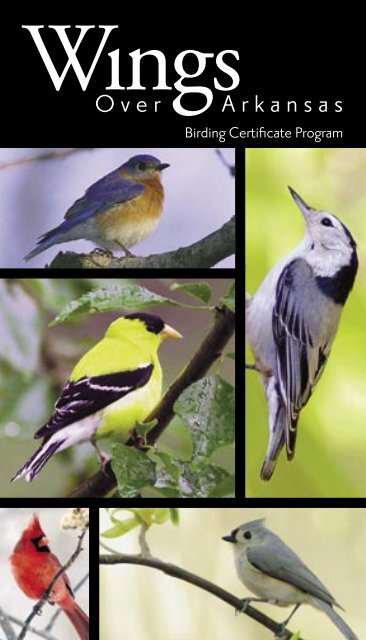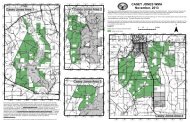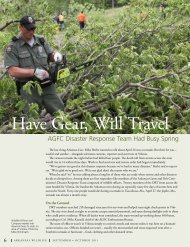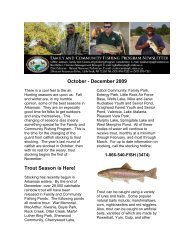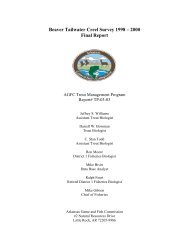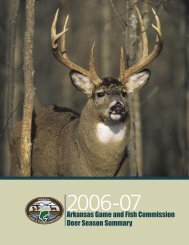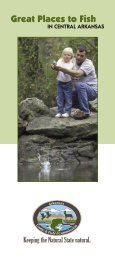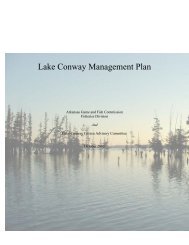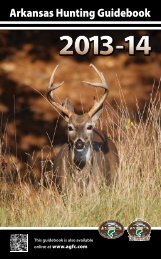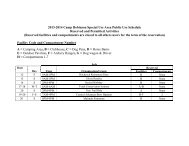Birding Certificate Program - Arkansas Game and Fish Commission
Birding Certificate Program - Arkansas Game and Fish Commission
Birding Certificate Program - Arkansas Game and Fish Commission
Create successful ePaper yourself
Turn your PDF publications into a flip-book with our unique Google optimized e-Paper software.
<strong>Birding</strong> <strong>Certificate</strong> <strong>Program</strong>
Passerine Bird <strong>Program</strong> Coordinator<br />
Catherine Rideout<br />
Watchable Wildlife Coordinator<br />
Kirsten Bartlow<br />
Editor<br />
R<strong>and</strong>y Zellers<br />
Designer<br />
Angela Sanchez<br />
Cover photos by Tom Elliott<br />
From top left, clockwise: Eastern bluebird,<br />
white-breasted nuthatch, tufted titmouse,<br />
northern cardinal, American goldfinch<br />
WOA program materials<br />
This brochure is part of the <strong>Arkansas</strong><br />
<strong>Game</strong> <strong>and</strong> <strong>Fish</strong> <strong>Commission</strong>’s Wings Over<br />
<strong>Arkansas</strong> program. Contact the AGFC<br />
at (501) 223-6351 or toll-free at (800)<br />
364-4263 ext. 6351 for additional copies<br />
of the complete Wings Over <strong>Arkansas</strong><br />
application package, including the <strong>Arkansas</strong><br />
Bird Checklist. <strong>Program</strong> materials also are<br />
available at www.agfc.com/wingsoverar or<br />
by e-mail at wingsoverar@agfc.com.<br />
<strong>Arkansas</strong>’<br />
F e a t h e r e d f r i e n d s<br />
american white pelican<br />
<strong>Arkansas</strong> is a beautiful state<br />
encompassing a diversity<br />
of habitats. From the Ozark<br />
<strong>and</strong> Ouachita mountains to the<br />
Mississippi Delta, every corner<br />
of the state offers something<br />
different. And each habitat is home<br />
to an entire cast of feathered friends.<br />
In addition to the birds that are<br />
year-round residents, many species<br />
of Neotropical migrants can be seen<br />
during fall <strong>and</strong> spring migrations<br />
through The Natural State. About<br />
400 species of birds have been<br />
documented in <strong>Arkansas</strong>, <strong>and</strong> the<br />
list grows every year.<br />
LARRY ROBERTS
peregrin e falcon<br />
Wings Over <strong>Arkansas</strong> is an awardbased<br />
program recognizing bird<br />
watchers’ contributions to <strong>Arkansas</strong>’<br />
outdoors. Mail a completed Wings Over<br />
<strong>Arkansas</strong> application <strong>and</strong> a copy of your<br />
current <strong>Arkansas</strong> Bird Checklist <strong>and</strong> receive<br />
a decorative pin <strong>and</strong> certificate identifying<br />
your level of birding experience. Contact<br />
the <strong>Arkansas</strong> <strong>Game</strong> <strong>and</strong> <strong>Fish</strong> <strong>Commission</strong><br />
at (800) 364-4263 ext. 6351 or visit<br />
www.agfc.com/wingsoverar for more<br />
information.<br />
Official rules<br />
■<br />
■<br />
■<br />
■<br />
■<br />
All bird listings must include species<br />
name, date <strong>and</strong> location of sighting.<br />
All birds listed must be in <strong>Arkansas</strong><br />
when identified.<br />
All birds listed must be alive, wild<br />
<strong>and</strong> unrestrained when observed.<br />
All birds listed must be identified by<br />
sight or sound by the person submitting<br />
the application.<br />
Retroactive bird lists are acceptable.<br />
Six levels of achievement<br />
Carolina Chickadee Level<br />
25-49 birds recorded on your<br />
<strong>Arkansas</strong> Bird Checklist<br />
Wood Duck Level<br />
50-99 birds recorded on your<br />
<strong>Arkansas</strong> Bird Checklist<br />
Belted Kingfisher Level<br />
100-174 birds recorded on your<br />
<strong>Arkansas</strong> Bird Checklist<br />
Scissor-tailed Flycatcher Level<br />
175-249 birds recorded on your<br />
<strong>Arkansas</strong> Bird Checklist<br />
Peregrine Falcon Level<br />
250-299 birds recorded on your<br />
<strong>Arkansas</strong> Bird Checklist<br />
Swallow-tailed Kite Level<br />
300 or more birds recorded on your<br />
<strong>Arkansas</strong> Bird Checklist
see birds well with the naked eye. A pair of<br />
7x35 or 8x42 binoculars is ideal for getting<br />
a closer look<br />
without<br />
weighing you<br />
down.<br />
In-the-field<br />
E s s e n t i a l s<br />
eastern towhee<br />
Just like anglers need fishing line <strong>and</strong><br />
kayakers need paddles, bird watchers<br />
have greatest success <strong>and</strong> most enjoyment<br />
when they bring the right equipment to the<br />
field.<br />
The most valuable<br />
items a birder can<br />
carry in the field<br />
include binoculars <strong>and</strong><br />
a field guide. It<br />
can be difficult to<br />
binocula rs<br />
camera<br />
Although<br />
many advanced<br />
birders feel<br />
confident taking<br />
to the woods<br />
field guides<br />
without a field guide, most people should<br />
consider investing in one to help with bird<br />
identification.<br />
Many outdoors enthusiasts<br />
have discovered the value of<br />
taking along a camera on their<br />
wildlife hikes. Photographing<br />
the birds you see adds<br />
another dimension to your<br />
bird-watching adventures.<br />
Wearing brightly colored clothing <strong>and</strong> even<br />
a blaze orange vest can make the woods<br />
much safer for birders venturing out during<br />
hunting seasons. Bright colors identify the<br />
wearer <strong>and</strong> won’t spook most birds.
<strong>Birding</strong><br />
E t h i c s<br />
■<br />
Do not enter private property<br />
without the owner’s explicit<br />
permission.<br />
The American <strong>Birding</strong> Association has<br />
developed guidelines to provide the<br />
best possible birding experience <strong>and</strong> protect<br />
the animals you are watching:<br />
■<br />
Promote the welfare of birds <strong>and</strong><br />
■<br />
■<br />
Be courteous to other outdoors<br />
enthusiasts you encounter.<br />
Ensure artificial nest structures,<br />
feeders <strong>and</strong> other attractors are<br />
safe.<br />
their environment.<br />
■<br />
Keep dispensers, water <strong>and</strong> food<br />
red-bellied woodpecker<br />
■<br />
■<br />
■<br />
■<br />
■<br />
■<br />
Support the protection of important<br />
bird habitat.<br />
Avoid stressing birds or exposing<br />
them to danger.<br />
Limit the use of recordings <strong>and</strong><br />
other methods of attracting birds.<br />
Keep your distance from nests,<br />
nesting colonies, roosts, display<br />
areas <strong>and</strong> important feeding sites.<br />
Stay on roads, trails <strong>and</strong> paths to<br />
prevent habitat destruction.<br />
Respect the law <strong>and</strong> the rights of<br />
others.<br />
■<br />
■<br />
■<br />
■<br />
■<br />
clean <strong>and</strong> free of decay or disease.<br />
Place attractors in areas protected<br />
from cats <strong>and</strong> other domestic<br />
animals <strong>and</strong> clear of dangers from<br />
windows <strong>and</strong> other structures.<br />
Underst<strong>and</strong> <strong>and</strong> practice good<br />
group birding etiquette.<br />
Respect fellow birders <strong>and</strong> other<br />
outdoors enthusiasts.<br />
Freely share your knowledge <strong>and</strong><br />
experience <strong>and</strong> be especially helpful<br />
to beginning birders.<br />
Keep groups small enough so they<br />
will not interfere with others or<br />
impact the environment.
Wild l<strong>and</strong>s in <strong>Arkansas</strong> aren’t the<br />
only places to see the most colorful<br />
creatures in the state. Thous<strong>and</strong>s of<br />
bird-watching enthusiasts enjoy the<br />
antics of birds in their back yards.<br />
Enhancing your back yard<br />
F o r t h e b i r d s<br />
Birds need the same things as all<br />
wildlife – food, water <strong>and</strong> shelter from<br />
predators <strong>and</strong> weather. Most of these things<br />
are probably already in your back yard, but<br />
you may not recognize it.<br />
Many birds such as this Eastern<br />
bluebird enjoy a refreshing dip in<br />
birdbaths filled with clean water.<br />
One of the easiest<br />
<strong>and</strong> most effective<br />
ways to help the birds<br />
in your area is to<br />
plant native shrubs,<br />
flowers <strong>and</strong> grasses.<br />
Native plants do well<br />
in <strong>Arkansas</strong>’ soils<br />
<strong>and</strong> climate, so they<br />
require little ground<br />
preparation or<br />
watering. They provide better habitat <strong>and</strong><br />
food for birds, butterflies, frogs <strong>and</strong> other<br />
backyard wildlife. If you still want a turflike<br />
yard, arrange native plants around the<br />
edges of your property or in clusters. Many<br />
native plants have bright blooms similar to<br />
cultivated flowers.<br />
Providing feeders is another excellent way<br />
to keep the birds coming to your property.<br />
Many home-improvement stores <strong>and</strong><br />
discount chains carry these inexpensive yard<br />
ornaments. You also can make feeders as<br />
easily as rolling a pine cone in peanut butter<br />
or vegetable shortening <strong>and</strong> birdseed. When<br />
placing your feeders, consider possible<br />
dangers, such as run-ins with windows or
the family cat. To reduce the chance of a bird<br />
colliding with a window, place feeders far<br />
away from windows or very close to them.<br />
Outdoor cats kill millions of birds every<br />
year. Consider keeping your cat indoors.<br />
It protects your backyard birds, <strong>and</strong><br />
your cat will have a much healthier<br />
life. Placing feeders near evergreen<br />
shrubs provides escape cover from<br />
predators. Be sure to clean feeders<br />
often to prevent disease.<br />
Once you have frequent visitors, you<br />
may want to put up some birdhouses<br />
to provide nesting sites for cavity-nesting<br />
birds. Bluebirds <strong>and</strong> purple martins are<br />
especially fond of manmade housing, but<br />
many other species use them for roosting <strong>and</strong><br />
nesting. You can buy birdhouses, but many<br />
people enjoy building them.<br />
Plans for birdhouses, ranging from the average<br />
bluebird box to homes for owls, are available<br />
in “Woodworking for Wildlife.” The 50-<br />
page book includes instructions for building<br />
wildlife homes <strong>and</strong> tips on where<br />
to place them in your yard. It costs $6.50<br />
<strong>and</strong> can be ordered by calling the AGFC<br />
at (800) 364-4263.<br />
yellow-bellied sapsucker<br />
Resources<br />
F o r b i r d e r s<br />
Birds of a feather<br />
Joining a birding club is an excellent<br />
way to meet fellow bird watchers <strong>and</strong><br />
gather for trips <strong>and</strong> bird-watching<br />
events. <strong>Birding</strong> clubs also are a<br />
great way to learn more about bird<br />
identification <strong>and</strong> conservation, <strong>and</strong> to<br />
pick up tips on how to attract <strong>and</strong> find<br />
more birds in your area. Here are two<br />
<strong>Arkansas</strong> birding organizations that can<br />
help you find fellow birders:<br />
<strong>Arkansas</strong> Audubon Society<br />
www.arbirds.org<br />
Audubon <strong>Arkansas</strong><br />
Heritage West Building<br />
201 E. Markham St., Suite 450<br />
Little Rock, AR 72201<br />
(501) 244-2229<br />
www.ar.audubon.org
Suggested reading<br />
Sibley’s <strong>Birding</strong> Basics. David Allen<br />
Sibley. Alfred A. Knopf, 2002.<br />
Birds of Eastern <strong>and</strong> Central North<br />
America. Fifth Edition. Roger Tory<br />
Peterson <strong>and</strong> Virginia Marie Peterson.<br />
Houghton Mifflin Company, 2002.<br />
<strong>Arkansas</strong> Birds. D.A. James <strong>and</strong> J.C.<br />
Neal. The University of <strong>Arkansas</strong> Press,<br />
1986.<br />
<strong>Arkansas</strong> Watchable Wildlife Guide.<br />
<strong>Arkansas</strong> <strong>Game</strong> <strong>and</strong> <strong>Fish</strong> <strong>Commission</strong>,<br />
2003. Order at www.agfc.com or by<br />
calling (800) 364-4263.<br />
<strong>Birding</strong> on the Web<br />
Cornell Lab of Ornithology<br />
http://birds.cornell.edu/<br />
The American <strong>Birding</strong> Association<br />
www.americanbirding.org<br />
Birds of <strong>Arkansas</strong><br />
www.birdsofarkansas.org<br />
<strong>Arkansas</strong> <strong>Birding</strong> Discussion Group<br />
www.arbirds.org/arbirds_discussion.html
www.agfc.com<br />
c=85 m=19 y=0 k=0 c=57 m=80 y=100 k=45 c=20 m=0 y=40 k=6<br />
or PMS 299<br />
or PMS 476<br />
or PMS 578<br />
2 Natural Resources Drive<br />
c=15 m=29 y=33 k=0 c=100 m=0 y=91 k=42 c=30 m=0 y=5 k=0<br />
or Little PMS 480 Rock, or PMS 349 AR 72205<br />
or PMS 2975<br />
(800) 364-4263


